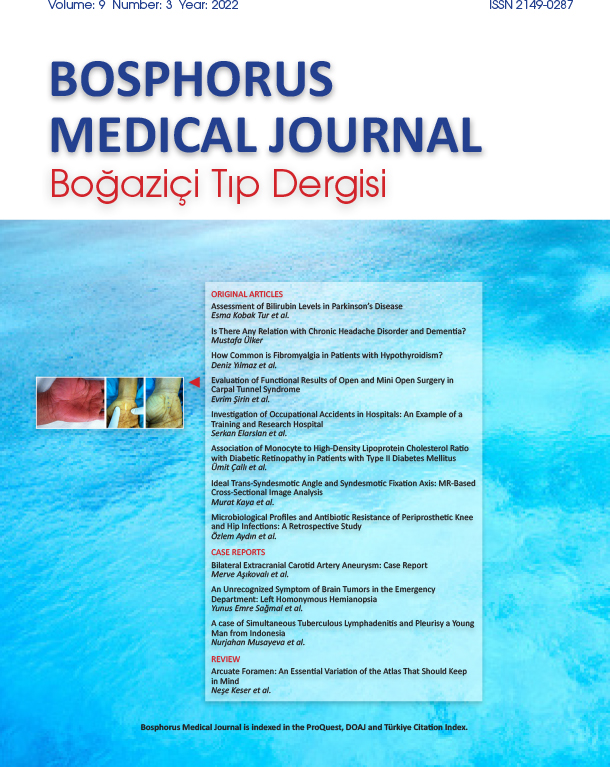Volume: 4 Issue: 1 - 2017
| ORIGINAL RESEARCH | |
| 1. | Hemifasiyal Spazm Olgularında Kranial MRI Bulguları Eren Gözke, Zehra Aktan, Sıdıka Sinem Taşdemir, Hilal Taştekin Toz, Pelin Doğan Ak, Burcu Seher Anıl doi: 10.15659/bogazicitip.17.02.656 Pages 1 - 3 INTRODUCTION: Clonic hemifacial spasm (HFS) is a disorder characterized by involuntary contractions of muscles innervated by facial nerve on one side of face and it negatively affects daily life. The aim of this study was to investigate cranial MRI findings in patients with HFS. METHODS: Cranial MRI findings of 92 patients (53 female, 39 male) who have HFS were evaluated radiologically. RESULTS: Age range and mean ages of cases were 23-81 and 55,5 ± 13,1, respectively. Cranial MRI was normal in 40 (43,4%) patients. We detected small vessel disease in 46 (50%), dolicoectasic basilar artery in 7 (7,6%), cerebral atrophy in 6 (6,5%), benign tonsillar ectopi in 2 (2,1%), arachnoid cyst in pontocerebellar angle in 1 (1,08%), pontocerebellar angle tumor in 1 (1,08%), and periventricular demyelinating plaque in 1 (1,08%) of the patients. DISCUSSION AND CONCLUSION: Clonic HFS can occur due to any pathology in the course of facial nerve. In our patients cranial MRI showed direct irritation of facial nerve in only 9 (9,7%) cases (dolicoectasic basilar artery, arachnoid cyst and tumor in pontocerebellar angle). The presence of small vessel disease in half of the patients suggests relationship between atherosclerotic process and occurrence of clonic HFS. |
| 2. | Evaluation of Short-term Effectiveness of Ultrasound-guided Injection in Treatment of Piriformis Syndrome Duygu Geler Külcü, Nilgün Mesci, Sevilay Çüçen Batıbay, Aslıhan Taraktaş, İlknur Aktaş doi: 10.15659/bogazicitip.17.02.662 Pages 4 - 7 INTRODUCTION: The purpose of this study was to evaluate the short-term efficacy of ultrasound (US)-guided steroid and local anaesthetic (LA) injections in patients with piriformis syndrome (PS). METHODS: 17 patients (14/3: female/male; mean age 56.2 years) were diagnosed with PS based on clinical history, tenderness on piriformis muscle, Freiberg test, Pace sign and flexion-adduction-internal rotation (FAIR) test results. Patients who had all tests positive were considered as PS. The therapeutic effect was evaluated at baseline and 1 week after the US-guided injection by visual analog scale (VAS: 0-10) during sitting, tenderness on the piriformis muscle (absent/present), Pace sign (absent/present), Freiberg test (absent/present) and FAIR test (absent/present). Statistical analysis were done with McNemar test and Wilcoxon test. RESULTS: VAS improved from 9.2±1.4 to 3.7±0.1 (p<0.001). Tenderness (82%), Freiberg test (80%), Pace sign (75%) and FAIR test (82%) significantly dissapeared (p<0.001). DISCUSSION AND CONCLUSION: US-guided steroid combined with LA injection may be an effective treatment option for patients with PS. |
| 3. | Usage Area of D-Dimer in Emergency Service and Relation with Age in Pulmonary Embolism Senem Bıçakçı, Fatma Sarı Doğan, Özlem Güneysel doi: 10.15659/bogazicitip.17.02.652 Pages 8 - 15 INTRODUCTION: To investigate D-dimers area and frequency of use in patients admitted to emergency department. In addition; D-dimers sensitivity and specificity by age with the use of the formula age x 10 in patients older then fifty years old suspected of pulmonary embolism. METHODS: One thousand and five hundred and ninety three patients admitted to University of Health Sciences Kartal Dr. Lütfi Kırdar Education and Research Hospital Emergency Department between 1st January and 31st December 2014 were included in the study. Plasma D-dimer levels were measured by immunoturbidimetric assay and cut-off value is considered 500 ng/ml. RESULTS: Plasma D-dimer level of 747 patients (46,9%) were less than 500 ng/ml, 846 patients (53,1%) had a D-dimer above 500 ng/ml. In the high measured D-dimer group, the mean age of the patients 62,17±20,36 (15-113) years. 54,1% (n=458) were female. Pulmonary disease (19.1%) was the most frequent diagnosis and most required imaging modality was chest x-ray (43,9%) in the high measured D-dimer group. Sensitivity, specificity and negative predictive value of D-dimer for pulmonary embolism were 90%, 88% and 99%, respectively. Sensitivity, specificity and negative predictive value of D-dimer for deep vein thrombosis were 93%, 97% and 99%, respectively. DISCUSSION AND CONCLUSION: Sensitivity, specificity and especially negative predictive value of D-dimer for pulmonary embolism and deep vein thrombosis are very high. In patients older than fifty years old suspected of pulmonary embolism, the formula age x 10 ng/ml can be used for the D-dimers cut-off value therefore sensitivity and specificity of D-dimers are increased. |
| 4. | A Six-month Experience with Dexamethasone Implant for Recurrent Macular Edema Secondary to Retinal Vein Occlusion Ayşe Yağmur Kanra, Meltem Güzin Altınel, Sevil Arı Yaylalı, Aylin Ardagil Akçakaya doi: 10.15659/bogazicitip.17.02.659 Pages 16 - 20 INTRODUCTION: To evaluate 6-month results after a single application of intravitreal dexamethasone implant (IDI) for recurrent macular edema in retinal vein occlusion(RVO). METHODS: Twenty non-naive eyes with macular edema secondary to RVO underwent assessments for central macular thickness (CMT), best corrected visual acuity (BCVA) and adverse events at baseline, week 1 and monthly until reinjection due to recurrence (range 3-6 months) retrospectively following IDI. Retreatment criterion was recurrence on OCT and related to loss of BCVA at least 1 line. RESULTS: Fourteen eyes with branch retinal vein occlusion, and 6 eyes with central retinal vein occlusion were eligible for the study. The mean age was 63.7±10.3 and 60% of the patients were women. Both mean BCVA and CMT significantly improved 1 week, 1, 2, 3 and 4 months (p<0.05) after injection. Moreover, the increase of visual acuity was sustained in 70% of the patients even in case of recurrence. The maximum response to IDI was observed in the second month and improvements in visual acuity and retinal thickness began to decrease from the third month. The maximum value of IOP after IDI was 34 mmHg and measured at month 2 as well. IOP rises were well controlled with topical antiglaucoma therapy. No serious adverse events were observed during follow-up period. DISCUSSION AND CONCLUSION: According to our short-term results, IDI seems to be an effective and safe treatment for recurrent macular edema in RVO with the maximum effect at month 2. |
| 5. | The Effect of Preoperative Anemia in Treatment of Hip Fractures with Partial Hip Arthroplasty On Hospital Length of Stay Serkan Akçay, Akif Albayrak, Hakan Bahar, Salih Söylemez, Murat Demiroğlu, Necati Emirhan, Bülent Kılıç doi: 10.15659/bogazicitip.17.02.660 Pages 21 - 25 INTRODUCTION: The objective of this study was analysing the correlation between preoperative anemia and duration of hospitay stay at preoperative and postoperative stage among patients that had been treated with partial endoprosthesis for treatment of pertrochanteric femoral fractures. METHODS: Medical records of 152 individuals were reviewed retrospectively and 135 patients were included to the study. Preoperative anemia was detected in 87 of patients. Remaining 48 patients hemoglobin levels were within normal ranges. Both patient groups were statistically examined with respect to mean age, distribution of morbidity, preoperative and postoperative hemoglobin values, duration of hospital stay before and after surgery and transfusion requirement. RESULTS: When hypertension, coronary artery disease, diabetes mellitus, Alzheimers disease and transfusion ratios are examined, no statistically significant difference was found between groups (p>0,05). No statistically significant difference was found between the age averages of anemic and non-anemic patients (p>0,05). Preoperative and postoperative hemoglobin values of patients in the anemic group were found to be significantly low compared to the averages of patients in the non-anemic group (p<0,05). Preoperative and postoperative hemoglobin value differences of patients in the non-anemic group were found to be significantly high compared to the differences of patients in the non-anemic group (p<0,05). Preop hospital stay periods of patients with anemia were found to be significantly higher in comparison to those of patients without anemia (p<0,05). DISCUSSION AND CONCLUSION: Our results showed that there is no statistically significant difference between anemic and nonanemic groups by the means of postoperative hospitalstay consistent with the current literature. However we have detected statistically significant longer preoperative hospital stay in anemic group. We believe that this finding is valuable since the fact that duration of preoperative hospital stay increases postoperative mortality. |
| 6. | The Effect of Pain, Range of Motion and Muscle Strength on Activities of Daily Living in Patients with Lateral Epicondylitis Hülya Çağlıyan Hartevioğlu, Melek Güneş Yavuzer, Pınar Akpınar doi: 10.15659/bogazicitip.17.02.657 Pages 26 - 32 INTRODUCTION: To evaluate the effect of pain, range of motion and muscle strength in the patients with lateral epicondylitis on activities of daily living. METHODS: Sixty people who were admitted to outpatient clinic of Physical Medicine and Rehabilitation within the Fatih Sultan Mehmet Education and Research Hospital on dates between January - April 2014, and diagnosed as LE were included in the study. The severity of pain during night, rest, activity, and forced activity was assessed with Visual Analog Scale (VAS), the range of motion was measured by a goniometer, muscle strength was assessed by measuring hand grip strenght using a dynamometer, activity and participation were assessed with Short form of the Disabilities of Arm, Shoulder and Hand Questionnaire (Quick-DASH) and Forearm Evaluation Questionnaire Based with Patient (HBÖKDA), and Quality of Life was assessed with Short Form 36 (SF-36). RESULTS: The age of subjects were between 19 and 64 years and mean age was 47,95±8,6 years. There was a significant relationship between the severity of pain and the Quick-DASH, DASH-W, HBÖKDA, and SF-36 (p ˂ 0,05). There was no significant relationship between the range of motion and the Quick-DASH, DASH-W, HBÖKDA and SF-36 (p > 0,05). There was a significant relationship between the hand grip strength and the pain section of HBÖKDA in subjects whom right elbow was affected and there was a significant relationship between the hand grip strength and the Quick-DASH, DASH-W, and function section of HBÖKDA in subjects whom left elbow was affected (p< 0,05). There wasnt any significant relationship between the hand grip strength and the SF-36 scores in subjects whom right elbow was affected (p> 0,05) but, there was a significant relationship between the hand grip strength and the SF-36 scores other than vitality scores in subjects whom left elbow was affected (p< 0,05). DISCUSSION AND CONCLUSION: Pain and weakness in grip strength cause limitation at the activities of daily living and decrease the quality of life in patients with lateral epicondylitis. |




















